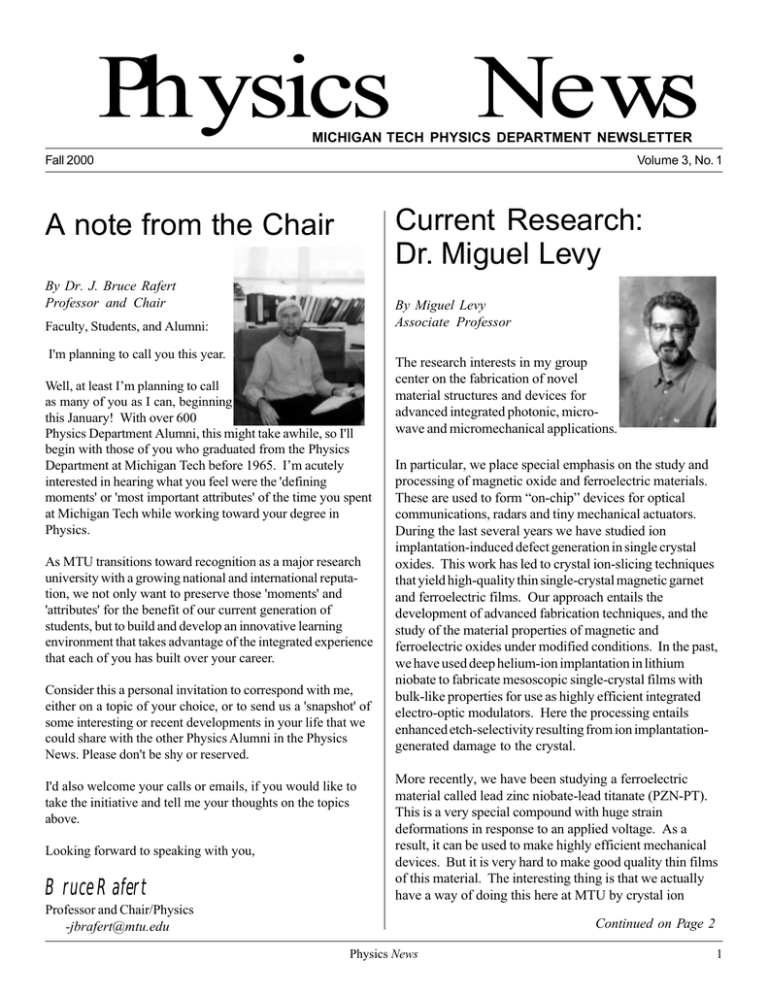Physics News Current Research: A note from the Chair Dr. Miguel Levy
advertisement

Physics News MICHIGAN TECH PHYSICS DEPARTMENT NEWSLETTER Fall 2000 Volume 3, No. 1 Current Research: Dr. Miguel Levy A note from the Chair By Dr. J. Bruce Rafert Professor and Chair By Miguel Levy Associate Professor Faculty, Students, and Alumni: I'm planning to call you this year. Well, at least Im planning to call as many of you as I can, beginning this January! With over 600 Physics Department Alumni, this might take awhile, so I'll begin with those of you who graduated from the Physics Department at Michigan Tech before 1965. Im acutely interested in hearing what you feel were the 'defining moments' or 'most important attributes' of the time you spent at Michigan Tech while working toward your degree in Physics. As MTU transitions toward recognition as a major research university with a growing national and international reputation, we not only want to preserve those 'moments' and 'attributes' for the benefit of our current generation of students, but to build and develop an innovative learning environment that takes advantage of the integrated experience that each of you has built over your career. Consider this a personal invitation to correspond with me, either on a topic of your choice, or to send us a 'snapshot' of some interesting or recent developments in your life that we could share with the other Physics Alumni in the Physics News. Please don't be shy or reserved. I'd also welcome your calls or emails, if you would like to take the initiative and tell me your thoughts on the topics above. Looking forward to speaking with you, Bruce Rafert The research interests in my group center on the fabrication of novel material structures and devices for advanced integrated photonic, microwave and micromechanical applications. In particular, we place special emphasis on the study and processing of magnetic oxide and ferroelectric materials. These are used to form on-chip devices for optical communications, radars and tiny mechanical actuators. During the last several years we have studied ion implantation-induced defect generation in single crystal oxides. This work has led to crystal ion-slicing techniques that yield high-quality thin single-crystal magnetic garnet and ferroelectric films. Our approach entails the development of advanced fabrication techniques, and the study of the material properties of magnetic and ferroelectric oxides under modified conditions. In the past, we have used deep helium-ion implantation in lithium niobate to fabricate mesoscopic single-crystal films with bulk-like properties for use as highly efficient integrated electro-optic modulators. Here the processing entails enhanced etch-selectivity resulting from ion implantationgenerated damage to the crystal. More recently, we have been studying a ferroelectric material called lead zinc niobate-lead titanate (PZN-PT). This is a very special compound with huge strain deformations in response to an applied voltage. As a result, it can be used to make highly efficient mechanical devices. But it is very hard to make good quality thin films of this material. The interesting thing is that we actually have a way of doing this here at MTU by crystal ion Professor and Chair/Physics -jbrafert@mtu.edu Continued on Page 2 Physics News 1 Current Research Gina Goudge, who worked as departmental coordinator for the past two years, has transferred to the International Advancement office. Congratulations, Gina! Continued from page 1 slicing. We are presently working on the placement of electrodes on these films as a preparatory step to making tiny flippers. Judy Brychta Chapman has joined the Physics Department as departmenal coordinator. Judy previously worked in Research Services at MTU. Welcome! The development of integrated waveguide magneto-optical and electro-optical devices for advanced telecommunications is another area of interest we are pursuing. In the past we have demonstrated the fabrication of various types of photonic waveguide devices, including optical filters and thin-film magnet Faraday rotators and isolators and the integration of magnet films onto waveguide isolators. At present we are working on the development of magnetic photonic crystals to enhance the Faraday response in thin film garnets for use in ultra-small magneto-optic isolators. Magnetic photonic crystals, and photonic crystals generally, are quite interesting structures that engender photonic bandgaps, that is, forbidden regions for certain types of light. These crystals can be used to steer light around sharp corners in microscopic photonic circuits, to trap light for possible use in highly efficient on-chip lasers, and for advanced optical isolators. -mlevy@mtu.edu Mary (Marg) Rohrer, who worked as a secretary in the Physics Department this past year, has moved to St. Ignace. Good luck and best wishes, Marg! Department Update Dr. Miguel Levy has two new Research Assistants working with him. Young Hwan Kim is working in the area of sputtering films for integrated photonics and microwave applications. Anup Bandyopadhyay is developing and testing novel thin-film ferroelectric actuators for micromechanical applications. Welcome to MTU! Sung M. Lee, Vice Provost Research Services and Dean of the Graduate School, who retired from the University on August 31, 2000 after 35 years of service, has been appointed Professor Emeritus. He joined the Physics faculty in 1965 as an assistant professor of physics and received the Universitys Research Award in 1971. The department extends best wishes to Dr. Lee for a happy retirement. Robert H. Mount, Assistant Professor, who retired from the department on December 22, 1999, has been appointed Professor Emeritus. Professor Mount has been a Professor in the Physics Department for 45 years. We send our heartiest congratulations to Professor Mount. Donald A. Daavettila, Associate Professor, who retired from the department on February 29, 2000, has been appointed Professor Emeritus. Professor Daavettila has been a Professor in the Physics Department for 36 years and continues to teach classes for the department on an interim basis. 2 Chris Mattson has joined the Physics Department as a secretary. She previously worked as a medical office receptionist at Portage Health Systems. Welcome to the department, Chris! A special welcome goes out to Dolores Perez-Ramirez, a Post Doctoral Research Assistant working with Dr. Robert Nemiroff on the SUPER-LOTIS instrument being deployed at Kitt Peak National Laboratory and Michigan Techs CONtinuous CAMera (CONCAM) project. Welcome to Ruth Franco, an Adjunct Assistant Professor, who is working with Dr. Ravi Pandey in the area of modeling of materials. View the Physics Department course offerings located at http://www.phy.mtu.edu/curriculum/courses.html Thanks! We extend our deepest appreciation to friends and alumni who have made a recent contribution to the department. We appreciate your continued interest in the Department of Physics at Michigan Technological University. Physics News Current Research: Dr. David F. Nitz a sample of charged particles in the shower in an array of sensors deployed on the ground. By David F. Nitz Associate Professor Associate Professor David Nitz is intrigued by the mystery of the very highest energy cosmic rays. Some of these cosmic rays, elementary particles and atomic nuclei which originate in the cosmos and travel great distances before striking the earth, have been observed to have energies more than 100 million times larger than can be created at the worlds largest particle accelerator. It is not understood how nature can generate such large energies in individual elementary particles or nuclei. Are they somehow accelerated in a grand cosmic accelerator? Or are they remnants from the creation of the universe? Michigan Tech is involved in several aspects of the construction of the observatory. Dr. Nitz, along with Postdoc Dr. Z. Szadkowski, and graduate students Alexei Dorofeev, Joe Darling, Jim Chye, and Melissa Trombley (EE) are developing advanced micro-electronics which recognize and capture the signatures of the arrival in ground based detectors of air showers produced by high energy cosmic rays. Thousands of these components will be provided by Michigan Tech for the observatory. Prof. J. Bruce Rafert, with the assistance of Dr. R. Nemiroff and Dr. D. Perez-Ramirez, will provide a device to monitor the clarity of the atmosphere by observing stars of known brightness at different atmospheric depths. A custom integrated circuit developed as part of our electronics development for Auger. The rate of these particles is very low. Typically only one of these particles strikes any square kilometer on earth in a century. The low rate demands an observatory with an enormous collecting area. A modern large optical telescope may have a collecting area (primary mirror) with a diameter of 8 meters. The corresponding cosmic ray telescope will have a collecting diameter of 60 kilometers! Michigan Tech is engaged in an active research program to address the mystery of the highest energy cosmic rays, and has banded together with scientists in 20 countries to construct and operate the Pierre Auger cosmic ray observatory. Construction of the southern hemisphere observatory, located in the province of Mendoza, Argentina, is underway. A second observatory at a northern hemisphere site in Utah is planned to follow. Dr. Nitz is the scientific spokesman for the northern hemisphere observatory. The cosmic ray observatory utilizes the earths atmosphere as a target for the high energy cosmic rays. When a cosmic ray strikes the atmosphere, it interacts typically within the first 70 gm/cm**2 and starts a nuclear+electromagnetic cascade, generating an extensive air shower. This shower travels to the surface of the earth at essentially the speed of light, and can be observed by detecting the isotropic light given off when nitrogen atoms in the air de-excite after being excited by the passage of charged particles in the shower. The shower can also be observed by detecting the passage of -dfnitz@mtu.edu Recent Degree Recipients Spring 2000 - Fall 2000 HaiHong, Che, MS Masato Hiratani, PhD Harry Leckenby, PhD Michael Tews, MS Kai-hua Xiang, PhD New Ph.D. Candidates Shankar Ghimire Zhaolin Lu Yong Peng Aleksandr Sergeyev Libo Song Raghav Rao Vanga Jiesheng Wang Qiang Yang Xiangqian Yu Physics News 3 Physics News Non-Profit Organization U.S. POSTAGE PAID Permit No. 11 Houghton, Michigan 49931 Michigan Technological University 1400 Townsend Drive Houghton, Michigan 49931-1295 CHANGE SERVICE REQUESTED To receive Physics News: Faculty Spotlight Dr. Sung M. Lee Vice Provost for Research, Dean of Graduate School - retired Professor Emeritus Please verify your correct name and address on our mailing label. If it is incorrect, fax this page with corrections. If you know of someone who might be interested in receiving Physics News, please fax the form to us, we’ll see that they get a copy. “Research is a journey. Success is important to all of us. Nobody likes to lose. The very fabric of our lives is woven with victories won on the playing field, in the board room, in the classroom, and in the laboratory. But what is often forgotten in the promotions and the celebrations and the paychecks and the vacations (all hard-earned) is the getting there. The journey.” Name, Title Company Name Address Fax to the Physics Department at (906) 487-2933, or e-mail jabrycht@mtu.edu Please help us continue to provide quality instructional facilities, laboratory equipment, and scholarships for physics students! I hereby make my gift of $_______ I hereby pledge my gift of $_______ I would like my gift to be used for: Physics CILIT Equipment Physics Miles Fellowship Discovery Lab Program Please make checks payable to the Michigan Tech Fund Michigan Technological University 1400 Townsend Drive Houghton, Michigan 49931 Physics Learning Center


